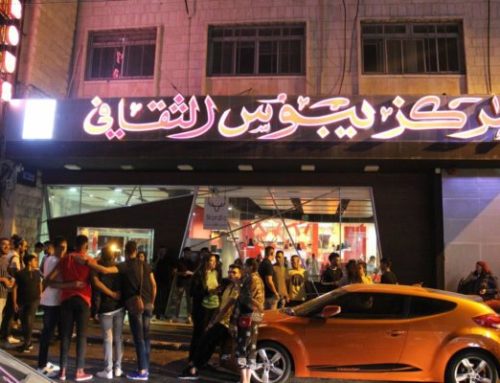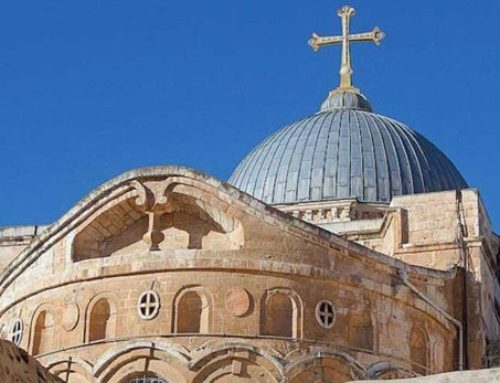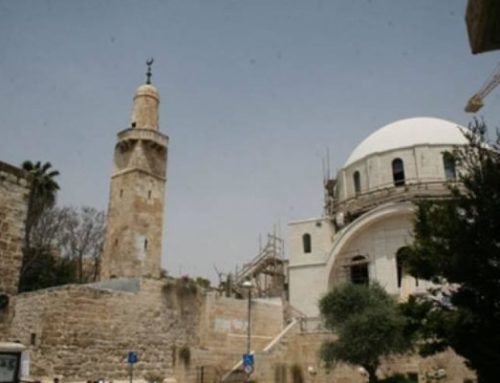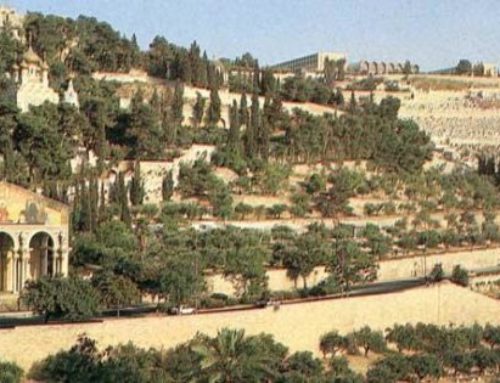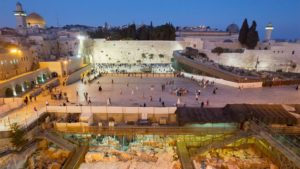
The Western Wall, which is 488 meters (1600 feet) long and 56 meters (184 feet) high, ends at the Al-Mughrabi Gate and has played a key role in the Palestinian-Israeli conflict over Jerusalem.[1] While Muslims believe the wall is part of Al-Aqsa Plaza, [2]Israelis believe it is part of the Second Temple and, thus, the holiest place on earth for the Jewish population, subsequently making it the place they pray three times a day .[3]
History and Names
Because Muslims believe part of that wall.[4]was used by the Islamic Prophet Mohammad to tie Al-Buraq, his animal, down while he accompanied Gabriel on the journey of Al-Israa and Al-Miraj, it is commonly referred to as the Al-Buraq Wall.[5] On the other hand, Israelis believe that the wall is part of their Second Temple.[6] built by Herod 18 B.C. and destroyed by Titus 70 A.D. whenever they pray next to the wall they cry and therefore call it the Wailing Wall.[7]However, in 2011, archeological excavations in line with the Western Wall and near the drainage system of the Old City uncovered an ancient ritual bath that was built after the Herodian era, which casts doubts on the historical origins of the wall.[8]
Al-Buraq Riots
Jews did not consider the wall to be part of the temple until after Balfour Declaration in 1917, and they started demanding that they be given ownership of the wall. Early clashes between Arabs and Jews sparked in 1928 over this issue. Great Britain, the Mandatory authority at the time, issued a report called the White Book in which it confessed that the wall belonged entirely to Arabs.[9] This, however, led to other more violent clashes between the two sides that ended up in what was known as “Al-Buraq Revolution” on the 23rd of August 1929. The clashes resulted in dozens of deaths on both sides and more than a 1000 people were tried in British Mandatory Courts. Of those tired, 26 were sentenced to death, but only three of them were actually executed.[10]
Following these clashes, the League of Nations formed an international committee under the presidency of the Swedish Minister of Exterior, Lil Lovegren. The committee studied documents and listened to witnesses and, in 1930, introduced its report to the League of Nations, which concluded that the wall belonged entirely to Arab Muslims as part of the Islamic endowment, along with the Moroccan neighborhood in front of it.[11]
Judization Policy
The wall and the area around it were subject to extensive Judization policies. This started with taking over the wall itself and extended to demolishing the Mughrabi (Moroccan) neighborhood in front of it. In June 1967, the site was captured by Israel after the Six Day War. Israel destroyed the Moroccan neighborhood displacing more than 100 Arab families.[12] The neighborhood that was dubbed Moroccan due to the historic presence of Moroccans, was an Islamic endowment that dates back to Saladin era in the eleventh century,[13]was completely destroyed in an operation that lasted three days and left a number of Palestinians killed as they refused to evacuate. The ethnic cleansing of Palestinians in the Buraq Arena did not stop there; Israel continued demolishing homes in the nearby Abu Al-Saoud neighborhood until July 2007, when the last house in the Buraq Arena was demolished.[14]
In trying to change the wall’s Arab character into a Jewish one, Israel has established religious centers and museums in the area.[15]It also has dug many tunnels near the wall, the most famous of which is the tunnel that extends along the wall with a length of 488 meters and ends in Al-Aqsa Plaza..[16]The tunnel connects with an ancient Roman tunnel that is 80 meters long and has its entrance next to the wall.[17]

International Confession of the Arab Ownership
In addition to the many reports that date back to the last century, the United Nations Educational, Scientific and Cultural Organization (UNESCO) issued a resolution concerning the Western Wall in which it stressed the Arab character and ownership of the wall and the area around it as a part of the Islamic endowment.[18]
[1] Joseph Millis, Jerusalem: the Illustrated History of the Holy City (London: Andre Deutsch, 2012),p 24 and “Al-Buraq Wall: and Islamic Endowment under the Israeli Control,” at https://www.aljazeera.net/encyclopedia/citiesandregions/2015/10/22/حائط-البراق
[2] The wall is connected to Al-Aqsa Plaza by a bridge that is called Al-Mughrabi Bridge and that is currently threatened by imminent collapse. (Millis, Jerusalem, p 25)
[3] Id p 24
[4] More specifically the southern part of the wall (Al-Buraq Wall: and Islamic Endowment under the Israeli Control)
[5]Aref Al-Aref, History of Jerusalem (Jerusalem: Al Andalus Library, 1999 fifth edition), p 498
[6] Although many believe that its is the outer wall of the temple and not an attached part. Millis, Jerusalem, p 24
[7] Al-Aref, History of Jerusalem, p 498
[8] Millis, Jerusalem, p 24
[9] Al-Buraq Wall: and Islamic Endowment under the Israeli Control
[10] The Palestinians who were executed were Fouad Hijazi, Mohammed Jamjoom and Atta Zeer. Al-Aref, History of Jerusalem, p 499 and Al-Buraq Wall: and Islamic Endowment under the Israeli Control.
[11] Al-Buraq Wall: and Islamic Endowment under the Israeli Control
[12] Millis, Jerusalem, p 25
[13] Palestinian National Authority Ministry of Information, Al-Quds Sights and Landmarks (2015), p 69-70 and Al-Aref, History of Jerusalem, p 498
[14] Ministry of Information, Sights and Landmarks, p 70
[15] Al-Buraq Wall: and Islamic Endowment under the Israeli Control
[16] Id
[17] Id
[18] UNESCO Resolution 200 EX/25 of 2016 at https://unesdoc.unesco.org/ark:/48223/pf0000245634
Pictures:
- https://www.aljazeera.net/encyclopedia/citiesandregions/2015/10/22/حائط-البراق
- https://mawdoo3.com/سبب_تسمية_حائط_البراق_بهذا_الاسم


